Exploring the Role of BCL2 Interactome in Cancer: A Protein/Residue Interaction Network Analysis
Simple Summary
Abstract
1. Introduction
2. Materials and Methods
2.1. Data Collection and Cleaning
2.2. Cancer Drivers and Drug Target Selection
2.3. Identification of Common Interactors with BCL2
2.4. PPI Network Using STRING
2.5. Identification of Hub Genes by Using Cytoscape
2.6. Functional Enrichment Analysis
2.7. Protein Structures’ Retrieval and Preparation
2.8. Protein–Protein Docking
2.9. Contact Analysis
2.10. Molecular Dynamics (MD) Simulation
3. Results
3.1. Identification of Cancer Drivers
3.2. Common Interactors of BCL2
3.3. Protein–Protein Interaction Analysis
3.4. Functional Enrichment Analysis
3.5. Docking Studies
3.6. Contact Analysis
3.7. Molecular Dynamics Studies
4. Discussion
5. Conclusions
Supplementary Materials
Author Contributions
Funding
Institutional Review Board Statement
Informed Consent Statement
Data Availability Statement
Acknowledgments
Conflicts of Interest
Abbreviations
| PINA | Protein Interactions Network Analysis |
| RING | Residue Interaction Network Generation |
| MOE | Molecular Operating Environment |
| STRING | Search Tool for the Retrieval of Interacting Genes |
| BHRF1 | Epstein–Barr Virus (EBV) BHRF1 protein |
| Vpr | HIV Vpr protein |
| vBCL2 | viral BCL2 homolog |
| KSHV | Kaposi’s Sarcoma-Associated Herpesvirus |
| BAX | BCL2 Associated X protein |
| BAK1 | BCL2 Antagonist Killer 1 protein |
| BCL2 | B-cell lymphoma 2 |
| BCL2L1 | BCL2 like 1 |
| BCL2A1 | B-cell lymphoma 2-related protein A1 |
| PMAIP1 | Phorbol-12-myristate-13-acetate-induced protein 1 |
| BBC3 | BCL2-binding component 3 |
| BCL2L11 | BCL2 like 11 |
| APAF1 | Apoptotic protease activating factor 1 |
| CASP1 | Caspase 1 |
| CASP3 | Caspase 3 |
| CASP8 | Caspase 8 |
| CASP9 | Caspase 9 |
| IL1B | Interleukin-1 beta |
| NLRP1 | NLR family pyrin domain containing 1 |
| BECN1 | Beclin 1 (autophagy-related protein 1) |
| PIK3C3 | Phosphoinositide 3-kinase catalytic subunit type 3 |
| ATG14 | Autophagy-related 14 protein |
| ESR1 | Estrogen Receptor 1 |
| REL | V-Rel avian reticuloendotheliosis |
| STAT5 | Signal transducer and activator of transcription 5 |
| JAK | Janus kinase-signal transducer |
| STAT | Activator of transcription pathway |
| PML-RARA | PML-RARA fusion protein |
| EBNA3C | Epstein–Barr Virus Nuclear Antigen 3C |
| RAF1 | Raf-1 proto-oncogene |
| MAPK1 | Mitogen-activated protein kinase 1 |
| JAK | Janus Kinase |
| STAT | Signal Transducer and Activator of Transcription |
| TNF | Tumor Necrosis Factor |
| DJ1 | Parkinson’s Disease Protein DJ-1 |
| BAD | BCL2-associated death promoter |
| BAK | BCL2-antagonist/killer |
| BCL-XL | B-cell lymphoma-extra large |
| BH1 | BCL2 homology domain 1 |
| BH2 | BCL2 homology domain 2 |
| SEPTIN4 | Septin 4 |
| ARTS | SEPTIN4 isoform ARTS |
| XIAP | X-linked inhibitor of apoptosis protein |
| BNIPL | BCL2 interacting protein-like |
| TP53 | Tumor protein p53 |
| BAG1 | BCL2-associated athanogene 1 protein |
| EGLN3 | EGL nine homolog 3 |
| SRC | Proto-oncogene tyrosine-protein kinase |
References
- Willis, S.; Day, C.L.; Hinds, M.G.; Huang, D.C.S. The Bcl-2-Regulated Apoptotic Pathway. J. Cell Sci. 2003, 116, 4053–4056. [Google Scholar] [CrossRef]
- Ebrahim, A.S.; Sabbagh, H.; Liddane, A.; Raufi, A.; Kandouz, M.; Al-Katib, A. Hematologic Malignancies: Newer Strategies to Counter the BCL-2 Protein. J. Cancer Res. Clin. Oncol. 2016, 142, 2013–2022. [Google Scholar] [CrossRef]
- Bruey, J.M.; Bruey-Sedano, N.; Luciano, F.; Zhai, D.; Balpai, R.; Xu, C.; Kress, C.L.; Bailly-Maitre, B.; Li, X.; Osterman, A.; et al. Bcl-2 and Bcl-XL Regulate Proinflammatory Caspase-1 Activation by Interaction with NALP1. Cell 2007, 129, 45–56. [Google Scholar] [CrossRef]
- Petros, A.M.; Olejniczak, E.T.; Fesik, S.W. Structural Biology of the Bcl-2 Family of Proteins. Biochim. Biophys. Acta 2004, 1644, 83–94. [Google Scholar] [CrossRef] [PubMed]
- Banjara, S.; Suraweera, C.D.; Hinds, M.G.; Kvansakul, M. The Bcl-2 Family: Ancient Origins, Conserved Structures, and Divergent Mechanisms. Biomolecules 2020, 10, 128. [Google Scholar] [CrossRef] [PubMed]
- Kuwana, T.; Newmeyer, D.D. Bcl-2-Family Proteins and the Role of Mitochondria in Apoptosis. Curr. Opin. Cell Biol. 2003, 15, 691–699. [Google Scholar] [CrossRef]
- Lin, H.-I.; Lee, Y.-J.; Chen, B.-F.; Tsai, M.-C.; Lu, J.-L.; Chou, C.-J.; Jow, G.-M. Involvement of Bcl-2 Family, Cytochrome c and Caspase 3 in Induction of Apoptosis by Beauvericin in Human Non-Small Cell Lung Cancer Cells. Cancer Lett. 2005, 230, 248–259. [Google Scholar] [CrossRef] [PubMed]
- Singh, R.; Letai, A.; Sarosiek, K. Regulation of Apoptosis in Health and Disease: The Balancing Act of BCL-2 Family Proteins. Nat. Rev. Mol. Cell Biol. 2019, 20, 175–193. [Google Scholar] [CrossRef]
- Gross, A. BCL-2 Family Proteins as Regulators of Mitochondria Metabolism. Biochim. Biophys. Acta 2016, 1857, 1243–1246. [Google Scholar] [CrossRef]
- Sedlak, T.W.; Oltvai, Z.N.; Yang, E.; Wang, K.; Boise, L.H.; Thompson, C.B.; Korsmeyer, S.J. Multiple Bcl-2 Family Members Demonstrate Selective Dimerizations with Bax. Proc. Natl. Acad. Sci. USA 1995, 92, 7834–7838. [Google Scholar] [CrossRef]
- Zou, J.; Yue, F.; Jiang, X.; Li, W.; Yi, J.; Liu, L. Mitochondrion-Associated Protein LRPPRC Suppresses the Initiation of Basal Levels of Autophagy via Enhancing Bcl-2 Stability. Biochem. J. 2013, 454, 447–457. [Google Scholar] [CrossRef] [PubMed]
- Excoffier, L.; Gouy, A.; Daub, J.T.; Shannon, P.; Markiel, A.; Ozier, O.; Baliga, N.S.; Wang, J.T.; Ramage, D.; Amin, N.; et al. Cytoscape: A Software Environment for Integrated Models of Biomolecular Interaction Networks. Nucleic Acids Res. 2017, 13, 2498–2504. [Google Scholar] [CrossRef]
- Huang, J.; MacKerell, A.D. CHARMM36 All-Atom Additive Protein Force Field: Validation Based on Comparison to NMR Data. J. Comput. Chem. 2013, 34, 2135–2145. [Google Scholar] [CrossRef]
- Bussi, G.; Donadio, D.; Parrinello, M. Canonical Sampling through Velocity Rescaling. J. Chem. Phys. 2007, 126, 014101. [Google Scholar] [CrossRef]
- Essmann, U.; Perera, L.; Berkowitz, M.L.; Darden, T.; Lee, H.; Pedersen, L.G. A Smooth Particle Mesh Ewald Method. J. Chem. Phys. 1995, 103, 8577–8593. [Google Scholar] [CrossRef]
- Wang, H.G.; Takayama, S.; Rapp, U.R.; Reed, J.C. Bcl-2 Interacting Protein, BAG-1, Binds to and Activates the Kinase Raf-1. Proc. Natl. Acad. Sci. USA 1996, 93, 7063–7068. [Google Scholar] [CrossRef] [PubMed]
- Blagosklonny, M.V.; Giannakakou, P.; el-Deiry, W.S.; Kingston, D.G.; Higgs, P.I.; Neckers, L.; Fojo, T. Raf-1/Bcl-2 Phosphorylation: A Step from Microtubule Damage to Cell Death. Cancer Res. 1997, 57, 130–135. [Google Scholar] [PubMed]
- Li, X.; Miao, X.; Wang, H.; Xu, Z.; Li, B. The Tissue Dependent Interactions between P53 and Bcl-2 in Vivo. Oncotarget 2015, 6, 35699–35709. [Google Scholar] [CrossRef]
- Wei, H.; Qu, L.; Dai, S.; Li, Y.; Wang, H.; Feng, Y.; Chen, X.; Jiang, L.; Guo, M.; Li, J.; et al. Structural Insight into the Molecular Mechanism of P53-Mediated Mitochondrial Apoptosis. Nat. Commun. 2021, 12, 2280. [Google Scholar] [CrossRef]
- Nehra, R.; Riggins, R.B.; Shajahan, A.N.; Zwart, A.; Crawford, A.C.; Clarke, R. BCL2 and CASP8 Regulation by NF-KappaB Differentially Affect Mitochondrial Function and Cell Fate in Antiestrogen-Sensitive and -Resistant Breast Cancer Cells. FASEB J. 2010, 24, 2040–2055. [Google Scholar] [CrossRef]
- Sharifi, S.; Barar, J.; Hejazi, M.S.; Samadi, N. Roles of the Bcl-2/Bax Ratio, Caspase-8 and 9 in Resistance of Breast Cancer Cells to Paclitaxel. Asian Pac. J. Cancer Prev. 2014, 15, 8617–8622. [Google Scholar] [CrossRef]
- Rautureau, G.J.P.; Yabal, M.; Yang, H.; Huang, D.C.S.; Kvansakul, M.; Hinds, M.G. The Restricted Binding Repertoire of Bcl-B Leaves Bim as the Universal BH3-Only Prosurvival Bcl-2 Protein Antagonist. Cell Death Dis. 2012, 3, e443. [Google Scholar] [CrossRef]
- Dai, Y.; Grant, S. BCL2L11/Bim as a Dual-Agent Regulating Autophagy and Apoptosis in Drug Resistance. Autophagy 2015, 11, 416–418. [Google Scholar] [CrossRef]
- Choi, H.-J.; Han, J.-S. Overexpression of Phospholipase D Enhances Bcl-2 Expression by Activating STAT3 through Independent Activation of ERK and P38MAPK in HeLa Cells. Biochim. Biophys. Acta (BBA)-Mol. Cell Res. 2012, 1823, 1082–1091. [Google Scholar] [CrossRef]
- Vrana, J.A.; Grant, S.; Dent, P. Inhibition of the MAPK Pathway Abrogates BCL2-Mediated Survival of Leukemia Cells after Exposure to Low-Dose Ionizing Radiation. Radiat. Res. 1999, 151, 559. [Google Scholar] [CrossRef] [PubMed]
- Laulier, C.; Barascu, A.; Guirouilh-Barbat, J.; Pennarun, G.; le Chalony, C.; Chevalier, F.; Palierne, G.; Bertrand, P.; Verbavatz, J.M.; Lopez, B.S. Bcl-2 Inhibits Nuclear Homologous Recombination by Localizing BRCA1 to the Endomembranes. Cancer Res. 2011, 71, 3590–3602. [Google Scholar] [CrossRef] [PubMed]
- Freneaux, P.; Stoppa-Lyonnet, D.; Mouret, E.; Kambouchner, M.; Nicolas, A.; Zafrani, B.; Vincent-Salomon, A.; Fourquet, A.; Magdelenat, H.; Sastre-Garau, X. Low Expression of Bcl-2 in Brca1-Associated Breast Cancers. Br. J. Cancer 2000, 83, 1318–1322. [Google Scholar] [CrossRef] [PubMed][Green Version]
- Edison, N.; Curtz, Y.; Paland, N.; Mamriev, D.; Chorubczyk, N.; Haviv-Reingewertz, T.; Kfir, N.; Morgenstern, D.; Kupervaser, M.; Kagan, J.; et al. Degradation of Bcl-2 by XIAP and ARTS Promotes Apoptosis. Cell Rep. 2017, 21, 442–454. [Google Scholar] [CrossRef]
- Mamriev, D.; Larisch, S. Another One Bites the Dust; ARTS Enables Degradation of Bcl-2 by XIAP. Mol. Cell. Oncol. 2018, 5, e1441630. [Google Scholar] [CrossRef]
- Oing, C.; Tennstedt, P.; Simon, R.; Volquardsen, J.; Borgmann, K.; Bokemeyer, C.; Petersen, C.; Dikomey, E.; Rothkamm, K.; Mansour, W.Y. BCL2-Overexpressing Prostate Cancer Cells Rely on PARP1-Dependent End-Joining and Are Sensitive to Combined PARP Inhibitor and Radiation Therapy. Cancer Lett. 2018, 423, 60–70. [Google Scholar] [CrossRef]
- Dutta, C.; Day, T.; Kopp, N.; van Bodegom, D.; Davids, M.S.; Ryan, J.; Bird, L.; Kommajosyula, N.; Weigert, O.; Yoda, A.; et al. BCL2 Suppresses PARP1 Function and Nonapoptotic Cell Death. Cancer Res. 2012, 72, 4193–4203. [Google Scholar] [CrossRef]
- Zhu, J.; Yang, Y.; Wu, J. Bcl-2 Cleavages at Two Adjacent Sites by Different Caspases Promote Cisplatin-Induced Apoptosis. Cell Res. 2007, 17, 441–448. [Google Scholar] [CrossRef][Green Version]
- Kirsch, D.G.; Doseff, A.; Chau, B.N.; Lim, D.S.; de Souza-Pinto, N.C.; Hansford, R.; Kastan, M.B.; Lazebnik, Y.A.; Hardwick, J.M. Caspase-3-Dependent Cleavage of Bcl-2 Promotes Release of Cytochrome c. J. Biol. Chem. 1999, 274, 21155–21161. [Google Scholar] [CrossRef] [PubMed]
- Wei, Y.; Sinha, S.C.; Levine, B. Dual Role of JNK1-Mediated Phosphorylation of Bcl-2 in Autophagy and Apoptosis Regulation. Autophagy 2008, 4, 949–951. [Google Scholar] [CrossRef] [PubMed]
- Jiang, Z.; Chen, X.; Zhou, Q.; Gong, X.; Chen, X.; Wu, W. Downregulated LRRK2 Gene Expression Inhibits Proliferation and Migration While Promoting the Apoptosis of Thyroid Cancer Cells by Inhibiting Activation of the JNK Signaling Pathway. Int. J. Oncol. 2019, 55, 21–34. [Google Scholar] [CrossRef] [PubMed]
- Su, Y.-C.; Guo, X.; Qi, X. Threonine 56 Phosphorylation of Bcl-2 Is Required for LRRK2 G2019S-Induced Mitochondrial Depolarization and Autophagy. Biochim. Biophys. Acta (BBA)-Mol. Basis Dis. 2015, 1852, 12–21. [Google Scholar] [CrossRef]
- Vantieghem, A.; Xu, Y.; Assefa, Z.; Piette, J.; Vandenheede, J.R.; Merlevede, W.; de Witte, P.A.M.; Agostinis, P. Phosphorylation of Bcl-2 in G2/M Phase-Arrested Cells Following Photodynamic Therapy with Hypericin Involves a CDK1-Mediated Signal and Delays the Onset of Apoptosis. J. Biol. Chem. 2002, 277, 37718–37731. [Google Scholar] [CrossRef]
- Terrano, D.T.; Upreti, M.; Chambers, T.C. Cyclin-Dependent Kinase 1-Mediated Bcl-XL/Bcl-2 Phosphorylation Acts as a Functional Link Coupling Mitotic Arrest and Apoptosis. Mol. Cell. Biol. 2010, 30, 640–656. [Google Scholar] [CrossRef]
- Yin, X.M.; Oltvai, Z.N.; Korsmeyer, S.J. BH1 and BH2 Domains of Bcl-2 Are Required for Inhibition of Apoptosis and Heterodimerization with Bax. Nature 1994, 369, 321–323. [Google Scholar] [CrossRef]
- Strappazzon, F.; Vietri-Rudan, M.; Campello, S.; Nazio, F.; Florenzano, F.; Fimia, G.M.; Piacentini, M.; Levine, B.; Cecconi, F. Mitochondrial BCL-2 Inhibits AMBRA1-Induced Autophagy. EMBO J. 2011, 30, 1195–1208. [Google Scholar] [CrossRef]
- Wei, H.; Wang, H.; Wang, G.; Qu, L.; Jiang, L.; Dai, S.; Chen, X.; Zhang, Y.; Chen, Z.; Li, Y.; et al. Structures of P53/BCL-2 Complex Suggest a Mechanism for P53 to Antagonize BCL-2 Activity. Nat. Commun. 2023, 14, 4300. [Google Scholar] [CrossRef]
- Davis, R.J. Signal Transduction by the JNK Group of MAP Kinases. Cell 2000, 103, 239–252. [Google Scholar]
- Bahar, M.E.; Kim, H.J.; Kim, D.R. Targeting the RAS/RAF/MAPK Pathway for Cancer Therapy: From Mechanism to Clinical Studies. Signal Transduct. Target. Ther. 2023, 8, 455. [Google Scholar]
- Kholodenko, B.N. Cell-Signalling Dynamics in Time and Space. Nat. Rev. Mol. Cell Biol. 2006, 7, 165–176. [Google Scholar]
- Westaby, D.; Jimenez-Vacas, J.M.; Figueiredo, I.; Pettinger, C.; Gurel, B.; Bogdan, D.; Rekowski, J.; Buroni, L.; Neeb, A.; Riisnaes, R.; et al. Abstract B020: BCL2 Expression Is Enriched in AR-Independent Advanced Prostate Cancer. Cancer Res. 2023, 83, B020. [Google Scholar] [CrossRef]
- Haughn, L.; Hawley, R.G.; Morrison, D.K.; von Boehmer, H.; Hockenbery, D.M. BCL-2 and BCL-XL Restrict Lineage Choice during Hematopoietic Differentiation. J. Biol. Chem. 2003, 278, 25158–25165. [Google Scholar] [CrossRef]

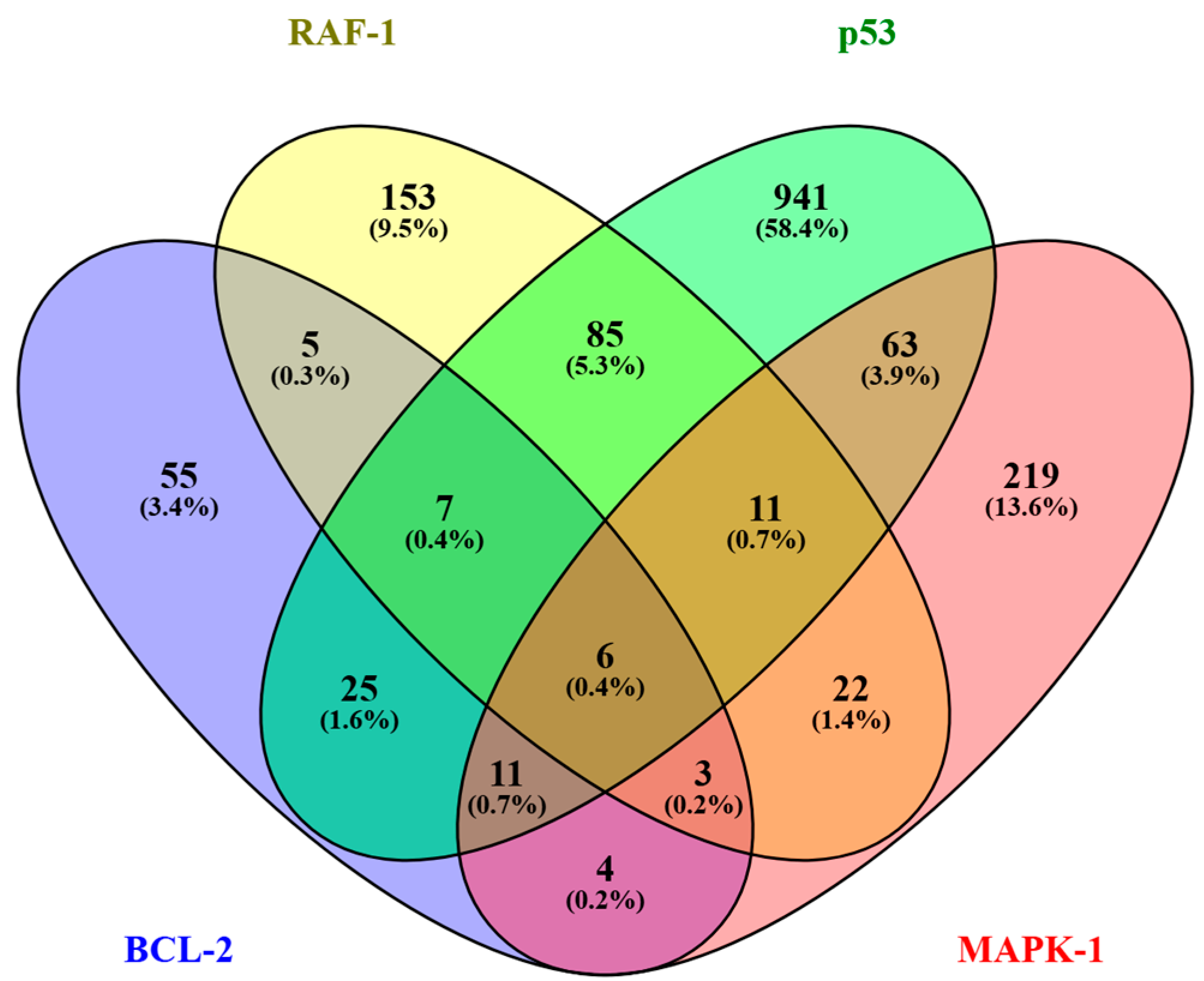

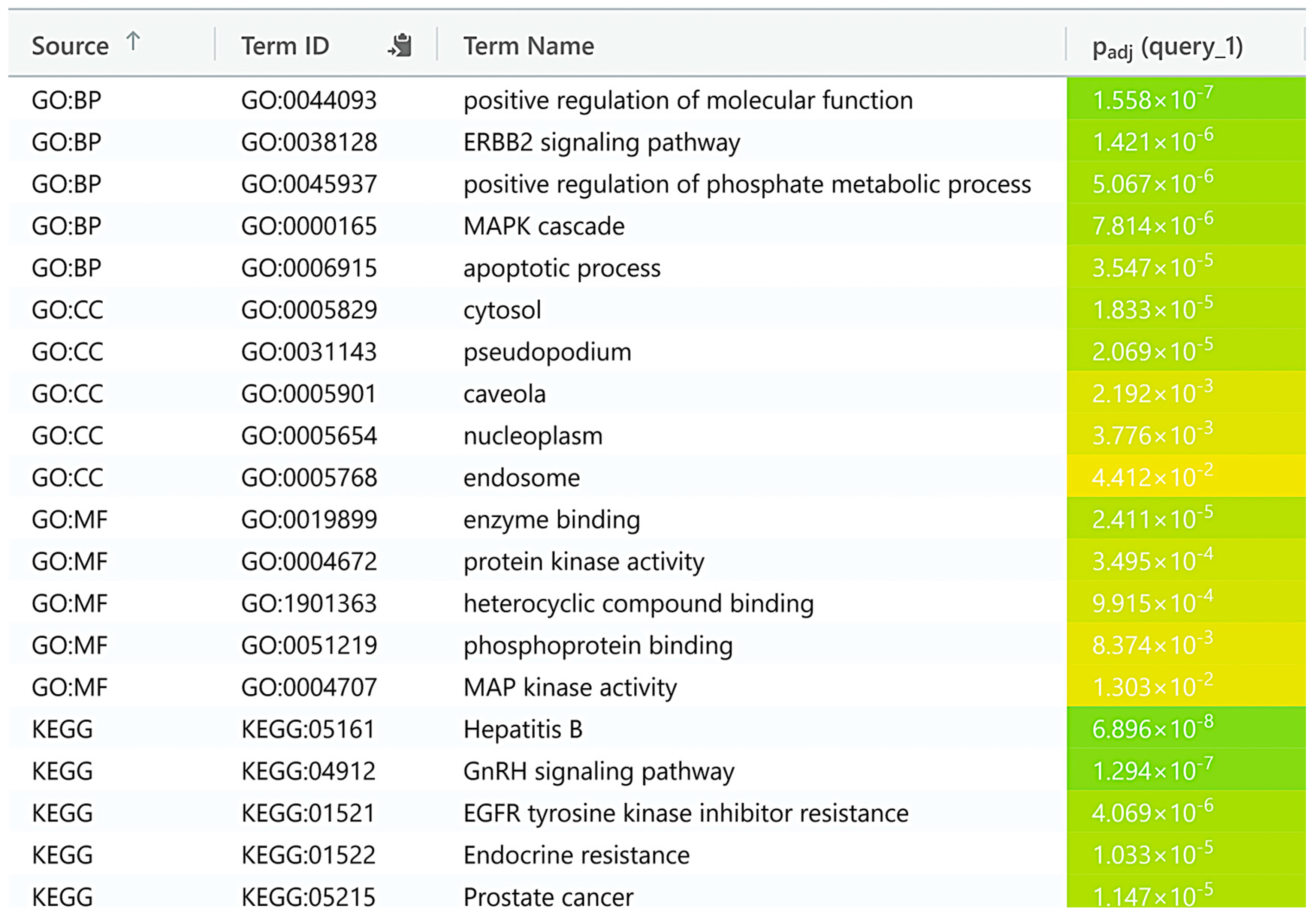
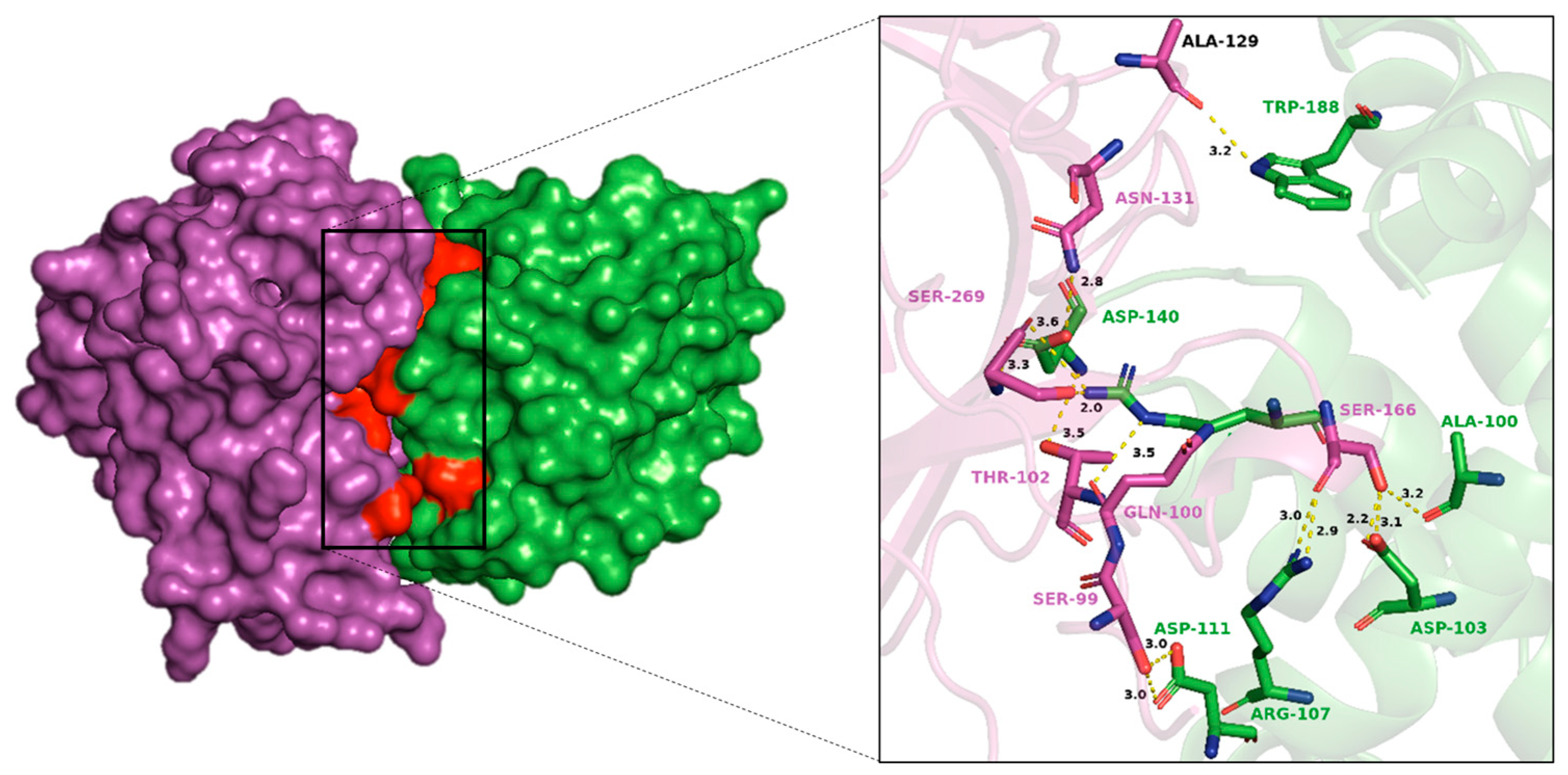
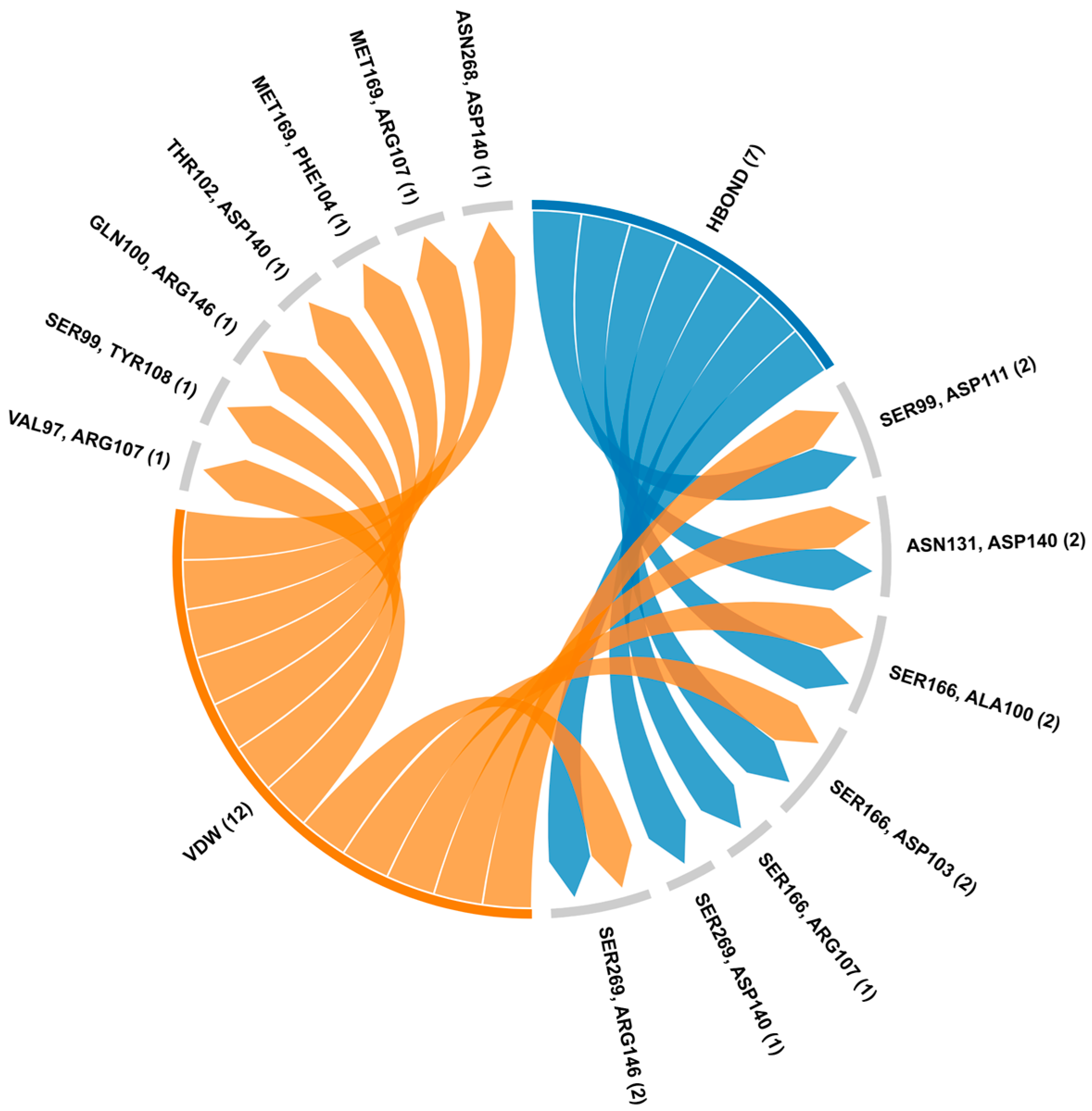
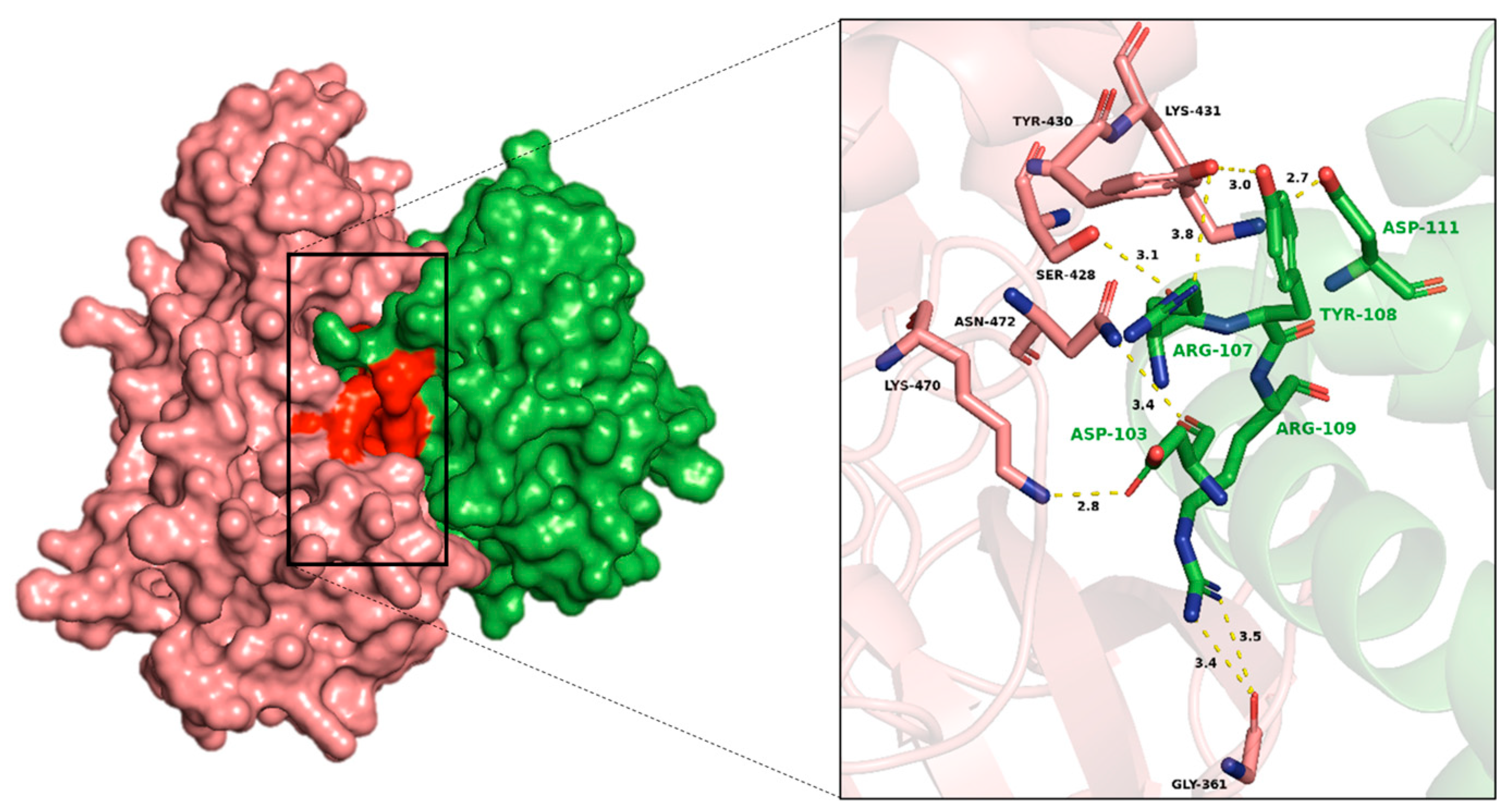

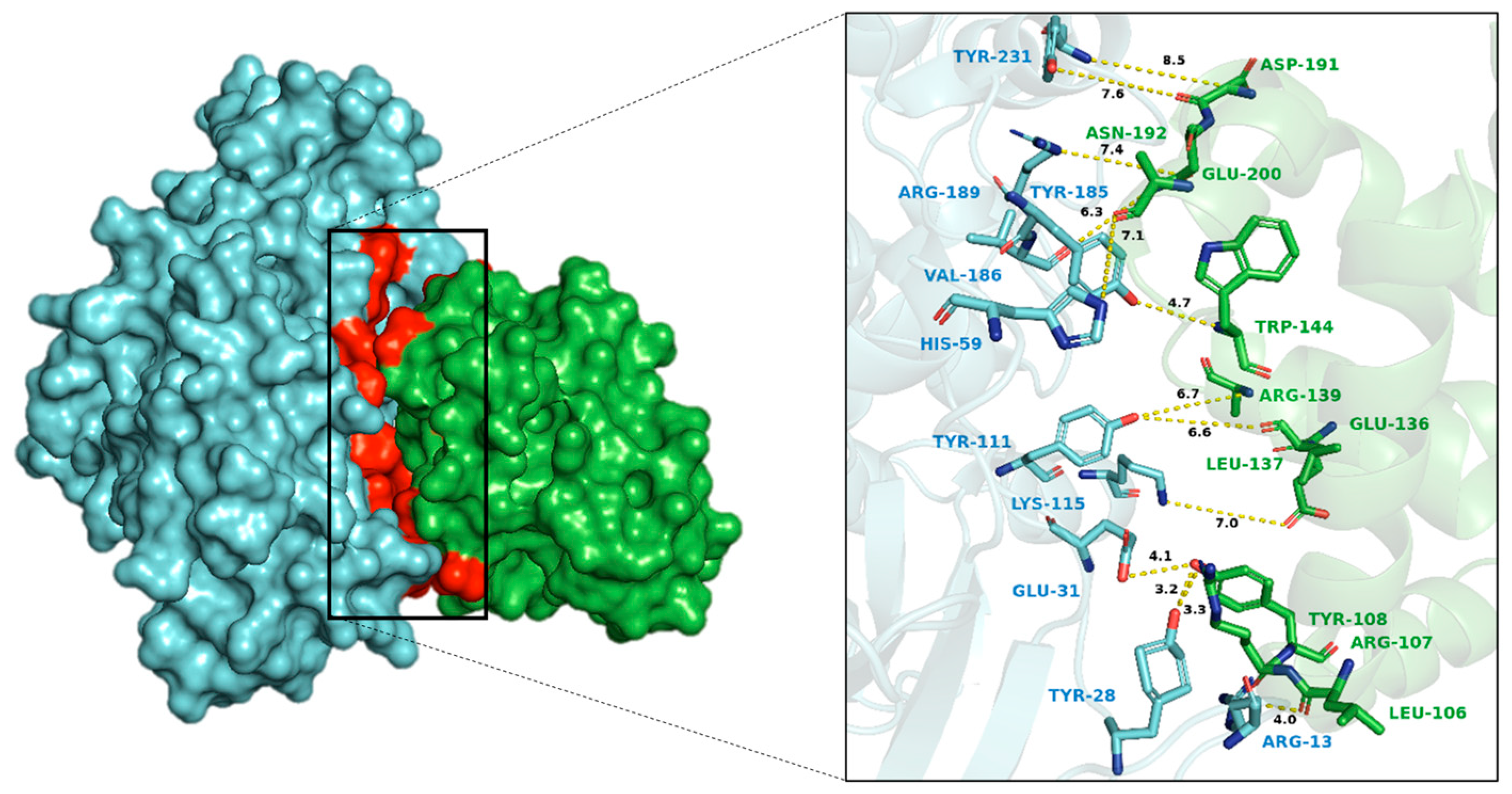
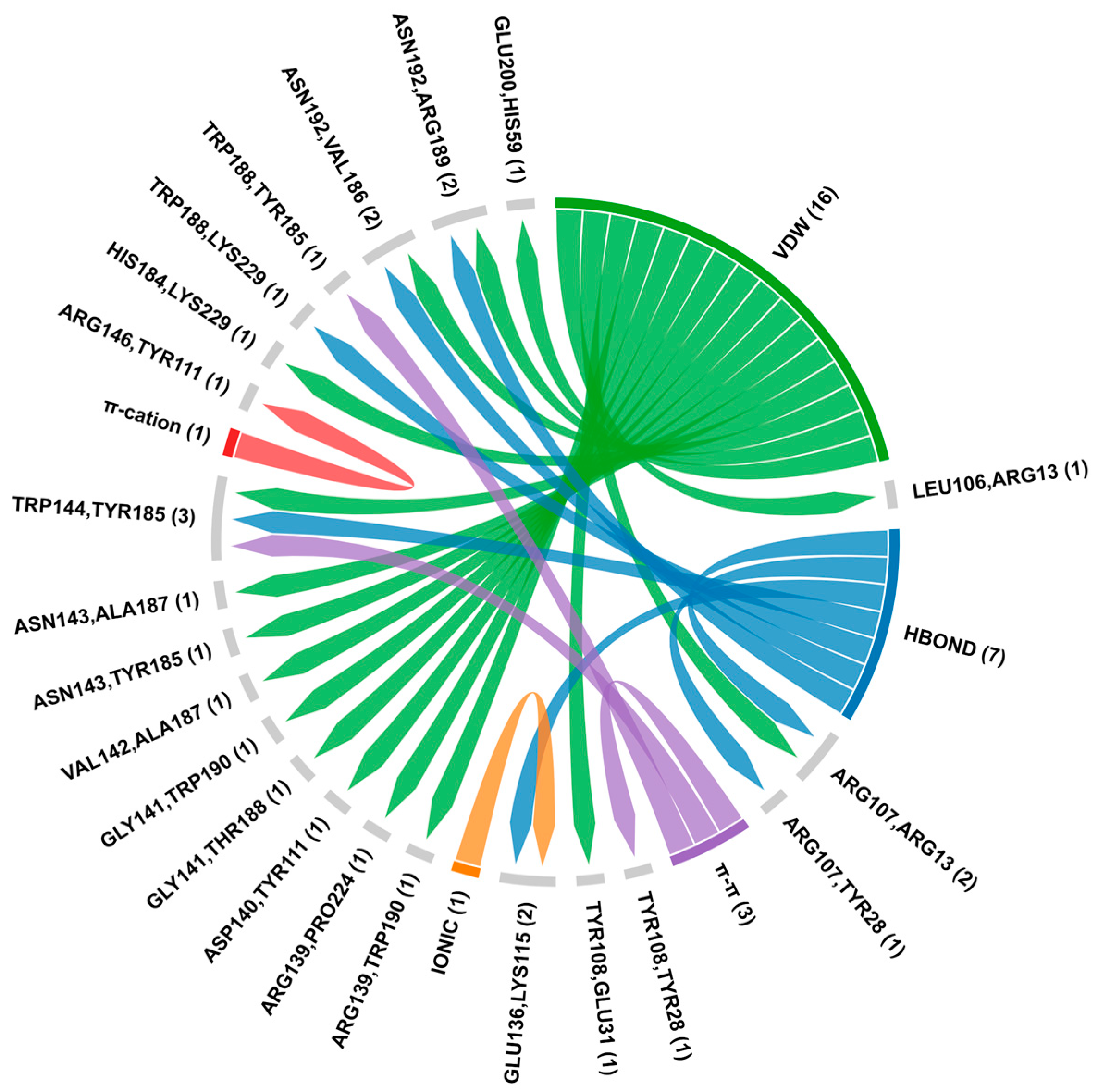



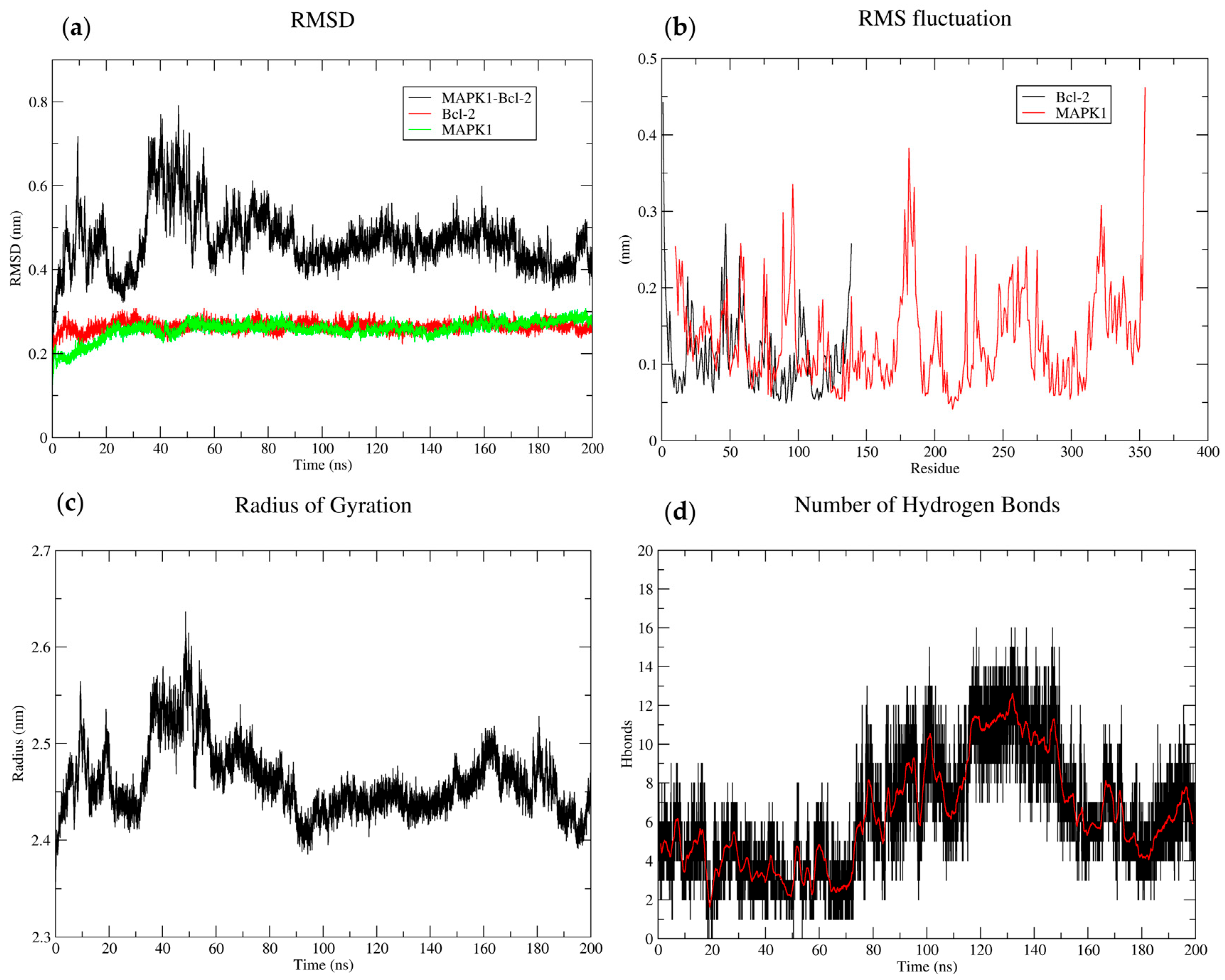
| Cancer Drivers | ||||
|---|---|---|---|---|
| Sr. | Uniprot | Gene Name | Protein Name | References |
| 1 | P04049 | RAF1 | RAF proto-oncogene serine/threonine-protein kinase | [16,17] |
| 2 | P04637 | p53 | Cellular tumor antigen p53 | [18,19] |
| 3 | Q14790 | CASP8 | Caspase 8 | [20,21] |
| 4 | O43521 | BCL2L11 | BCL2-like protein 11 | [22,23] |
| 5 | P28482 | MAPK1 | Mitogen-activated protein kinase 1 | [24,25] |
| 6 | P38398 | BRCA1 | Breast cancer type 1 susceptibility protein | [26,27] |
| Cancer Targets | ||||
| 1 | P04049 | RAF1 | RAF proto-oncogene serine/threonine-protein kinase | [16,17] |
| 2 | P98170 | XIAP | E3 ubiquitin-protein ligase XIAP | [28,29] |
| 3 | P09874 | PARP1 | Poly [ADP-ribose] polymerase 1 | [30,31] |
| 4 | P04637 | p53 | Cellular tumor antigen p53 | [18,19] |
| 5 | P42574 | CASP3 | Caspase 3 | [32,33] |
| 6 | P28482 | MAPK1 | Mitogen-activated protein kinase 1 | [24,25] |
| 7 | P45983 | MAPK8 | Mitogen-activated protein kinase 8 | [34] |
| 8 | Q5S007 | LRRK2 | Leucine-rich repeat serine/threonine-protein kinase 2 | [35,36] |
| 9 | P06493 | CDK1 | Cyclin-dependent kinase 1 | [37,38] |
| Name | Proteins | Structural Homology | Location | Functions | Uniprot ID |
|---|---|---|---|---|---|
| Pro-survival | BCL2 | BH1-4 domains and a transmembrane domain | ER, MOM, NM | Suppresses apoptosis | P10415 |
| BCL-XL | ER, MOM, NM | Inhibitor of cell death | Q07817 | ||
| BCLW | MOM, cytoplasm | Promotes cell survival | Q92843 | ||
| MCL-1 | Cytoplasm, MOM, nucleus | Regulation of apoptosis | Q07820 | ||
| A1 | Cytoplasm | Retards apoptosis | Q16548 | ||
| Effector proteins | BAX | Share homology in all four domains | Cytoplasm, MOM | Apoptosis | Q07812 |
| BAK | MOM, ER | Promotes apoptosis | Q16611 | ||
| BOK | Cytoplasm, ER, MOM | Apoptosis regulator | Q9UMX3 | ||
| BH3-only proteins | BAD | Share homology in the BH3 only domain | Cytoplasm, MOM | Promotes cell death | Q92934 |
| BID | Cytoplasm, MOM | Induces apoptosis | P55957 | ||
| BIK | ER, MM, NM | Accelerates apoptosis | Q13323 | ||
| BIM | MOM, cytoskeleton | Induces apoptosis | O43521 | ||
| PUMA | Cytoplasm, MOM | Mediator of p53, induces apoptosis | Q9BXH1 | ||
| Noxa | Cytoplasm, MOM | Promotes apoptosis | Q13794 | ||
| HRK | MOM | Promotes apoptosis | O00198 | ||
| BMF | Cytoplasm, MOM | Apoptosis | Q96LC9 | ||
| Tumor protein 53 | p53 | Cytoplasm, cytoskeleton, ER, mitochondrion, nucleus | Induces apoptosis | P04637 | |
| Serine/threonine kinase | RAF1 | Cytoplasm, nucleus, mitochondrion | Retards apoptosis | P04049 | |
| Mitogen-activated protein kinase 1 | MAPK1 | Cytoplasm, cell junction, cytoskeleton, mitochondrion, nucleus | Induces apoptosis | P28482 |
Disclaimer/Publisher’s Note: The statements, opinions and data contained in all publications are solely those of the individual author(s) and contributor(s) and not of MDPI and/or the editor(s). MDPI and/or the editor(s) disclaim responsibility for any injury to people or property resulting from any ideas, methods, instructions or products referred to in the content. |
© 2025 by the authors. Licensee MDPI, Basel, Switzerland. This article is an open access article distributed under the terms and conditions of the Creative Commons Attribution (CC BY) license (https://creativecommons.org/licenses/by/4.0/).
Share and Cite
Ilyas, S.; Lee, D. Exploring the Role of BCL2 Interactome in Cancer: A Protein/Residue Interaction Network Analysis. Biology 2025, 14, 261. https://doi.org/10.3390/biology14030261
Ilyas S, Lee D. Exploring the Role of BCL2 Interactome in Cancer: A Protein/Residue Interaction Network Analysis. Biology. 2025; 14(3):261. https://doi.org/10.3390/biology14030261
Chicago/Turabian StyleIlyas, Sidra, and Donghun Lee. 2025. "Exploring the Role of BCL2 Interactome in Cancer: A Protein/Residue Interaction Network Analysis" Biology 14, no. 3: 261. https://doi.org/10.3390/biology14030261
APA StyleIlyas, S., & Lee, D. (2025). Exploring the Role of BCL2 Interactome in Cancer: A Protein/Residue Interaction Network Analysis. Biology, 14(3), 261. https://doi.org/10.3390/biology14030261








